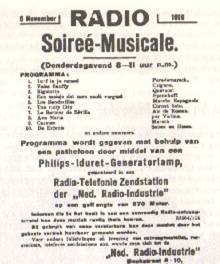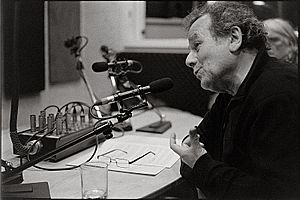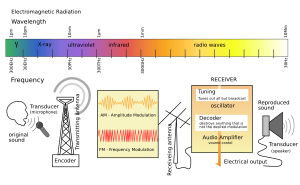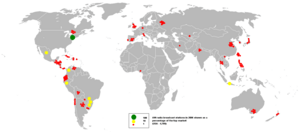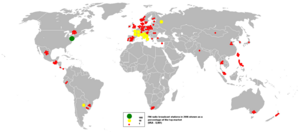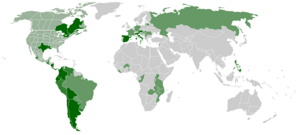Radio broadcasting facts for kids
Radio broadcasting is how we send sounds, like music, news, and talk shows, through the air using invisible radio waves. These waves travel from a radio station to your radio receiver, which then turns them back into sound.
There are two main ways radio waves are sent:
- Terrestrial radio broadcasting: The radio waves come from a station on land.
- Satellite radio: The radio waves are sent from a satellite orbiting Earth.
To listen, you need a radio receiver, often just called a "radio." Many radio stations are part of a larger radio network. This means they share programs or have a similar style of content.
Radio stations use different ways to send their signals:
- AM radio uses something called Amplitude Modulation.
- FM radio uses Frequency Modulation. These are older ways to send analog sound.
- Newer digital radio uses different digital methods like DAB, HD Radio, and DRM, which can offer clearer sound.
Television broadcasting is similar but sends video signals along with sound.
Contents
History of Radio Broadcasting
The very first radio systems could only send codes, not voices or music. To broadcast sound, new electronic devices were needed to detect and make signals stronger.
An important invention was the thermionic valve (a type of vacuum tube) in 1904 by John Ambrose Fleming. This device could control the flow of electricity, which was key for radio. Later, the triode was invented in 1906 by Robert von Lieben and Lee De Forest. This device could make weak radio signals much stronger.
By about 1920, these technologies were good enough for radio broadcasting to really begin. Some early broadcasts include:
- In 1906, Reginald Fessenden might have made an early audio broadcast on Christmas Eve, though this is debated.
- Charles Herrold started broadcasting in California in 1909. His station eventually became KCBS.
- In the Netherlands, PCGG began broadcasting on November 6, 1919.
- In the United States, Frank Conrad started broadcasting from his garage in 1916. His station was later relaunched as KDKA on November 2, 1920. KDKA was the first radio station in the U.S. to get a commercial license. Its first broadcast was the results of the 1920 U.S. presidential election.
- Other early stations like CFCF in Montreal and WWJ in Detroit also began broadcasting in 1920.
- In the UK, wireless entertainment broadcasts started in 1920 from the Marconi Research Centre. Famous singer Dame Nellie Melba made a broadcast on June 15, 1920, becoming the first international artist to sing live on radio.
- Radio Argentina began regular broadcasts in Buenos Aires on August 27, 1920.
By 1931, most homes in the U.S. had at least one radio. Colleges also started offering courses in radio broadcasting.
Types of Radio Stations
Radio broadcasting comes in many forms. The main types are AM and FM stations. There are also different kinds of stations based on who runs them:
- Commercial broadcasting: These stations usually play ads.
- Non-commercial educational (NCE) public broadcasting: These stations often focus on education or public service and don't play ads.
- Non-profit varieties: Similar to NCE, they don't aim to make money.
- Community radio: Run by and for a local community.
- Student-run campus radio stations: Operated by students at colleges or universities.
- Hospital radio stations: Provide entertainment for patients in hospitals.
Many stations also broadcast on shortwave bands using AM technology. These signals can travel thousands of miles, especially at night. Big international broadcasters like the BBC World Service and Voice of America use shortwave to reach listeners far away.
AM Radio
AM stations were the first type of broadcasting stations. AM stands for amplitude modulation. This means the radio wave's strength (amplitude) changes to match the sound signal.
AM radio is often heard on the medium-wave band (525 to 1,705 kHz in North America). In Europe, it also uses the long-wave band.
One challenge with AM radio is that its signal can be affected by electrical storms (lightning) and other electronic noise. However, AM signals are easy to pick up. You can even build a simple "crystal radio" receiver that doesn't need batteries if the signal is strong enough. This was a popular project for kids in the early days of radio!
AM signals travel differently during the day and night. During the day, they don't travel as far. But at night, they can bounce off the upper atmosphere (the ionosphere) and travel much longer distances. This is why you might hear stations from far away on AM radio at night.
FM Radio
FM stands for frequency modulation. This means the radio wave's frequency (how often it vibrates) changes to match the sound signal. FM radio usually broadcasts on VHF airwaves, from 88 to 108 MHz in most places.
Edwin Howard Armstrong invented wide-band FM radio in the 1930s. He wanted to solve the problem of radio interference that AM radio had. FM also offered much clearer sound quality. FM stations are spaced further apart on the radio dial (200 kHz apart) than AM stations. This wider space helps reduce interference and allows for better sound.
Unlike AM, FM signals are "line-of-sight." This means they travel in a straight line and don't bounce off the atmosphere like AM signals do. Because of this, FM radio has a shorter range than AM radio, but its reception is usually clearer and doesn't change much between day and night.
FM radio started in the U.S. in 1939, but it took a while to become popular. After World War II, the frequencies for FM radio were changed to the ones we use today. By the 1980s, most new radios included both AM and FM tuners, and FM became the most popular way to listen to radio, especially in cities. AM radio remained more common in rural areas due to its longer range.
Pirate Radio
Pirate radio refers to radio broadcasts that are illegal or not officially regulated. People often use this term for stations that broadcast for fun or political reasons without a license. Sometimes, these stations even broadcast from ships at sea!
Rules about radio vary a lot from country to country. A broadcast might be called "pirate" if it crosses a national border without permission, or if it uses too much power, or even if the content is not allowed.
Terrestrial Digital Radio
Digital radio broadcasting is a newer way to send radio signals. It first appeared in Europe in the 1990s and then in other countries like the United States.
- DAB (Digital Audio Broadcasting) is a system used mainly in the UK and South Africa.
- HD Radio is used in the United States and Canada. It allows digital broadcasts to be sent on frequencies right next to the older analog broadcasts.
- DRM (Digital Radio Mondiale) is another digital system used by some broadcasters worldwide.
Digital radio can offer clearer sound and sometimes more channels than traditional analog radio.
International Broadcasting
Some radio stations broadcast from one country to listeners in other countries. There are several reasons for this:
- Business: Commercial broadcasters might want to reach more people to sell advertising or subscriptions.
- Government reasons: Governments often fund international broadcasting to share their country's views or promote a positive image. For example, during the Cold War, stations like Radio Free Europe broadcast news to countries where information was censored.
- Religious reasons: Many stations are run by religious groups to share religious teachings, music, or worship services. Vatican Radio, for instance, broadcasts religious programs.
Other Ways to Get Audio Broadcasts
Besides traditional radio waves, there are other ways to get audio broadcasts:
- Cable radio: Sound sent through cable TV lines.
- Satellite radio: As mentioned, signals from satellites.
- Internet radio: Audio streamed over the internet. You can listen to stations from all over the world this way!
Satellite Radio
Satellite radio uses satellites in space to send signals. Because it costs a lot to launch and operate satellites, there are fewer satellite radio services compared to traditional radio. In the U.S. and Canada, for example, Sirius XM Satellite Radio is the main provider. Satellite radio can offer many channels and often covers a very wide area.
Radio Program Formats
Radio stations have different program formats, which means they play different types of content. For example, in the U.S., the 88-92 MHz band is set aside for non-profit or educational programs, and they are not allowed to have ads.
In the early days of radio, most programs were broadcast live. As technology improved, more and more programs were pre-recorded. Today, some radio stations are even automated, meaning computers play all the pre-recorded music and shows without direct human help.
See also
 In Spanish: Radio (medio de comunicación) para niños
In Spanish: Radio (medio de comunicación) para niños
- Call sign
- Disc jockey (DJ)
- History of broadcasting
- International broadcasting
- List of radio topics
- Radio
- Radio antenna
- Radio network
- Radio personality
- Television station


